India boasts of a rich historical past wherein it has been under the reign of several rulers who erected innumerable architectural gems during the course of their rule. Boasting of detailed embellishments and magnificent architecture, the monuments of India are representatives of one of the most stunning features of multi-featured culture of India.
A structural accomplishment in their own self, all the Indian monuments are wonderful samples of romance, bravery, mystery, artistry, skillfulness and more. They are witness of the past of the country, standing like sentinel pillars of the cultural heritage of India. These wonderful monuments are muses for the future generation and proud landmarks of their home cities too!
Here is the list of 20 Amazing Indian Monuments and Landmarks.
1. Taj Mahal, Agra
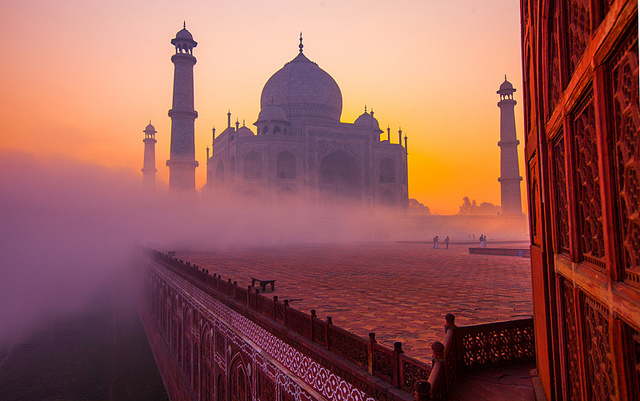
One of the Seven Wonders of the World and a UNESCO World Heritage Site, Taj Mahal stands like a dream on the southern banks of River Yamuna in Agra. This white marble mausoleum was commissioned in 1632 by Mughal Emperor Shah Jahan in the memory of his beloved wife Mumtaz Mahal.
The construction of this monument took 22 years. An amalgam of Persian and Mughal architecture, the mausoleum has been adorned with calligraphy, lattice work, precious and semi-precious stones.
See More:
Best Luxury Hotels in Agra
2. Amber Fort, Jaipur

Placed on the outskirts of Jaipur, Amber Fort or Amer Fort was the original home of the Rajput royalty before the establishment of Jaipur. One of the most popular attractions of Jaipur, this fort has expansive courtyard, temples, gardens, halls and palaces. This fort is a World Heritage Site along with five other hill forts of Rajasthan.
Erected by Raja Man Singh in 1592 with Rajput and Hindu elements, this fort holds several splendid structures within its walls such as Diwan-i-Am, Diwan-i-Khas, Sheesh Mahal, Suraj Pol, Sukh Mahal etc.
3. Golden Temple, Amritsar

Also known as Harmandir Sahib and Darbar Sahib, Golden Temple is a revered Sikh shrine that is visited by people of all faiths in huge numbers every year. Made up of marble, a distinguishing gold-plate upper part and dome is the best feature of this structure.
One of the five Takhts of the Sikh community called Akal Takht Sahib, its complex has a holy pond (Amrit Sarovar) where the visitors take a dip to wash away all their sins. A symbol of human brotherhood and equality, this sacred site was designed by Guru Arjan Dev Ji, the fifth Guru of Sikhism.
4. Mehrangarh Fort, Jodhpur

One of the largest forts in India, Mehrangarh fort is probably the most popular attraction of Jodhpur and a popular landmark too. This invincible beauty has been well-preserved and is positioned on a perpendicular cliff, guarding the ‘blue city’.
Constructed around 1460 by Rao Jodha (the founder of Jodhpur), this fort has as many as seven tall gates and houses a well-stocked museum too. Do not miss the royal palanquins, costumes, arms and paintings here. This mighty fort was built in a span of 500 years and this adorns several styles of architectures.
See More:
Top 20 Things To Do in Jodhpur
5. Swaminarayan Akshardham Temple, Delhi

Opened in the year 2005 for visitors, the expansive Swaminarayan Akshardham or Akshardham is a popular Hindu temple complex that lies on the banks of River Yamuna in east Delhi. One of the largest complete Hindu temple complexes in the word, it is dedicated to Lord Swaminarayan, the founder of Swaminarayan Hinduism, a modern sect of Hinduism.
A wonderful show of art, culture, history and architecture of India, this huge complex comprises of a musical fountain, a canteen, well-maintained lush garden, the main temple, and a special boat ride with movie (water show).
6. Qutab Minar, Delhi

A UNESCO World Heritage Site, Quab Minar boasts of being the world’s tallest brick minaret, erected in an early Indo–Islamic architecture. The second tallest minar in the country, this 73-m structure was erected 1193 by ruler Qutab-ud-din Aibak right after defeating of the last Hindu king of Delhi.
This is five-storeyed tower with beautiful elaborate carvings as well as verses from the holy book, Quran. The Qutub Minar complex is dotted with a number of other historical structures also such as Quwwat-ul-Islam Mosque, the Iron Pillar of Delhi, the Tomb of Imam Zamin, Alai Minar, the Tomb of Iltutmish and Ala-ud-din’s Madrasa and Tomb.
7. Agra Fort, Agra
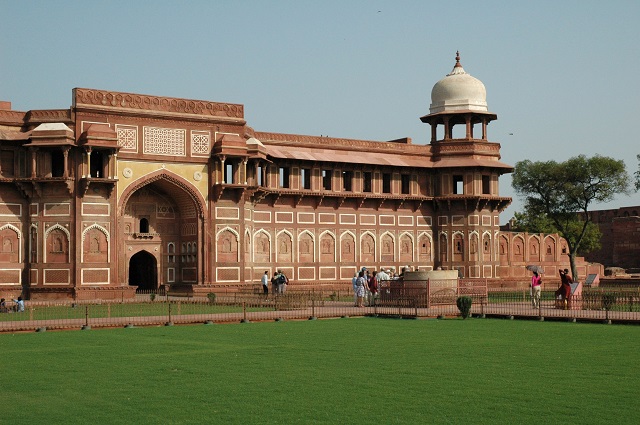
A UNESCO World Heritage Site in Agra, just 2.5 km away from the breathtaking Taj Mahal, the magnificent Agra Fort is one of the best Mughal structures in India. Originally a Rajputana brick fort, it was captured and reconstructed by Emperor Akbar, making it its capital in 1558. While the red sandstone part of the fort was by Emperor Akbar, the marble structures were commissioned by Emperor Shah Jahan.
Within the premises of the Agra Fort complex, there are a number of structures that are worth-exploring. Some of such buildings include Diwan i Am, DIwan i Khas, Jahangir Palace, Shesh Mahal, Moti Masjid, Palace of Jodha Bai, Anguri Bagh, Nagina Masjid, Saman Burj, Khas Mahal, Elephant Gate and so on.
8. Khajuraho Temples, Khajuraho

Khajuraho Group of Monuments, another popular World Heritage Site in India, is one of the most-visited attractions in Madhya Pradesh. Promoting erotica, love and worship, there are more than 20 temples, which are finest architectural marvels with detailed carvings. These stunning medieval monuments were erected by the Chandela rulers between AD 900 and 1130.
Divided into Eastern and Western Group of temples, they include Hindu as well as Jain places of worship. Lakshman temple, Chitragupta temple, Kandariya Mahadev temple, Vishwanath temple, Devi Jagadambi temple, Duladeo temple, Parsvanath temple, Adinath temple, Javari temple and Varaha temple along with other are some of the popular temples here.
9. Humayun’s Tomb, Delhi

Built in 1569-70 by Emperor Akbar, son of Emperor Humayun and designed by Mirak Mirza Ghiyas, a Persian architect, it is the tomb of Humayun. The first garden-tomb on the Indian subcontinent, this tomb is a UNESCO World Heritage Site. A synthesis of Persian architecture and Indian styles of architecture, this mausoleum has lovely water channels and pathways. This was the site where Emperor Bahadur Shah Zafar took refuge with 3 princes during the first war of Independence in 1857.
The Humayun tomb complex has a number of other structures too such as Tomb and mosque of Isa Kha, Afsarwala Tomb and mosque, Bu Halima’s Tomb and Garden, Nila Gumbad, Araba Sarai, Barber’s tomb, and Chillah Nizamuddin Aulia. Located opposite Nizamuddin Dargah, it can be visited from sunrise to sunset.
10. Brihadeeswarar Temple, Thanjavur
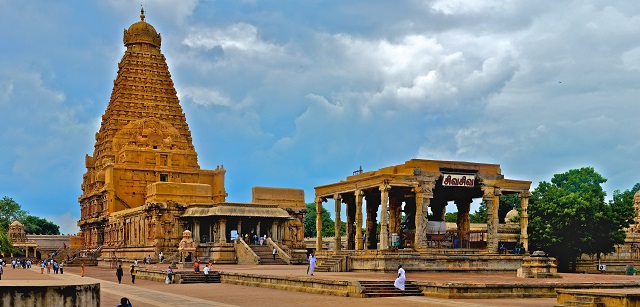
One of the finest and popular temples in South India, Brihadeeswarar Temple is erected out of granite stone and boasts of being over 1000 years old. One of the oldest temples in India that are dedicated to Lord Shiva, it has a dome that is higher than 60 m. Also known as Peruvudaiyar Kovil, RajaRajeswara Temple and Rajarajeswaram, it is a wonderful example of Dravidian temple architecture.
It is also one of India’s largest temples. A part of the World Heritage Site known as the Great Living Chola Temples, Brihadesswarar temple was commissioned during the Chola period. The main temple is in the center of the huge quadrangle-shaped complex and comprises of a Nandi bull statue, a pillared hall as well as an assembly hall / mandapa along with a number of other sub-shrines.
11. India Gate, Delhi

A popular landmark as well as one of the most popular attractions in Delhi, the India Gate is a war memorial, positioned on the Rajpath. This 42-m high structure takes its cue from Arc-de-Triomphe, its French equivalent. It was constructed as a commemoration of over 13,516 British and Indian soldiers who sacrificed their lives on the Northwestern Frontier in the Afghan war of 1919, carrying their names on its walls. It was designed by Sir Edwin Lutyens and its foundation was in 1921 laid by His Royal Highness, the Duke of Connaught.
Made of red Bharatpur stone, this structure also has an addition called Amar Jawan Jyoti, dedicated to those martyrs who laid their lives in the Indo-Pak war in 1971. The flame keeps burning day and night. The structure is surrounded by lush well-maintained lawns.
12. Gateway of India, Mumbai

Overlooking the Arabian Sea, one of the most popular landmarks as well as tourist attractions in Mumbai, the Gateway of India is placed on the waterfront in the Apollo Bunder area. Built in Indo-Saracenic style of architecture, it was made was to commemorate the visit of first British Monarch, King George V and Queen Mary to Bombay (Mumbai) in March 1911. However, the construction of the Gateway was completed only in 1924.
This daunting yellow basalt architecture is flocked by locals, tourists, photography enthusiasts as well as hawkers all throughout the day. This 26 m high structure has four towers and elaborate latticework.
13. Red Fort, Delhi

A UNESCO World Heritage Site in Delhi, the mighty Red Fort or Lal Quila was the official residence of the Mughal Emperor of India for around 200 years, until year 1857. Constructed in the year 1648 by the 5th Mughal Emperor in India Shah Jahan as the palace of his capital Shahjahanabad after coming from Agra, this red sandstone structure houses a number of well-stocked museums. It also boasts of owning a few huge gates like Lahori Gate, Delhi Gate and Water Gate.
The Drum House, the white marble Hall of Private Audiences, the Hall of Public Audiences, Palace of Color, the Pearl Mosque and Royal Baths are some of the popular structures inside the Red Fort Complex. A fusion of Timurid and Persian traditions of architecture, this mighty fort today becomes the venue of the main event on the Independence Day.
[ Read More About Red Fort in Delhi ]<
14. Mysore Palace, Mysore

Also known as the Amba Vilas Palace, Mysore palace the city’s popular landmark, is the residence as well as seat of the Wodeyars, the royal family of Mysore, who ruled from 1399 to 1950. The original palace was in wood that got burnt in 1897 during a wedding ceremony. Rebuilt in the year 1912, the present three-storey structure is in Indo-Saracenic style, bringing together Hindu, Rajput, Muslim, and Gothic architecture traditions.
Now turned into a museum, it possess priceless royal souvenirs, jewelry, paintings, costumes and other things, that were owned by the Wodeyars. Boasting of stunning stained glass and mirrors, this glorious palace every year becomes the venue for the very popular Mysuru Dasara festival. The palace complex comprises of Public Durbar Hall, Private Durbar, Gombe Thotti (Doll’s Pavilion), Portrait Gallery, Kalyana Mantapa, Casket room, and various temples such as Kodi Bharravasvami Temple, Sri Shweta Varahaswamy Temple, Sri Lakshmiramana Swami Temple etc.
15. Charminar, Hyderabad

One of the most popular mosques and monuments in Hyderabad, the Charminar was erected in 1591 CE by Mohammed Quli Qutab Shah, the 5th sultan of the Qutub Shahi dynasty of India. Positioned on the eastern banks of River Musi, this 400-yr old structure is often referred to as the ‘Arc de triomphe of the East’. This is a square- shaped structure with four festooned minarets in each of the corners, from where it derives its name.
With the popular Laad Bazaar on the west and beautifully ornamented Makkah Masjid on the southwest, the Charminar boasts of a bustling surrounding. From the gallery on the first floor, the visitors can enjoy a lovely views of the surrounding area. It is believed that the ruler built this structure to commemorate the eradication of plague, which was widespread at that time.
16. Meenakshi Amman Temple, Madurai

A popular landmark of Madurai and one of the most important temples in South India, Meenakshi Amman Temple is a Hindu temple that is placed on the banks of River Vaigai. One of the largest temple complexes in Tamil Nadu state, this magnificent Dravidian architecture is dedicated to Goddess Parvati, here known as Meenakshi, and her consort, Lord Shiva, known as Sundareswarar.
Encircled by high walls, the temple complex has 2 sanctums, dedicated to Sundareshwara and Meenakshi, enveloped by a few sub shrines and a pillared halls. The remarkable 12 gopurams of Meenakshi Amman temple are festooned with stucco figures of mythical animas, deities and monsters in various colors. The yearly 10-day Meenakshi Tirukalyanam festival, in April and May, attracts around 1 million devotees.
17. Hawa Mahal, Jaipur
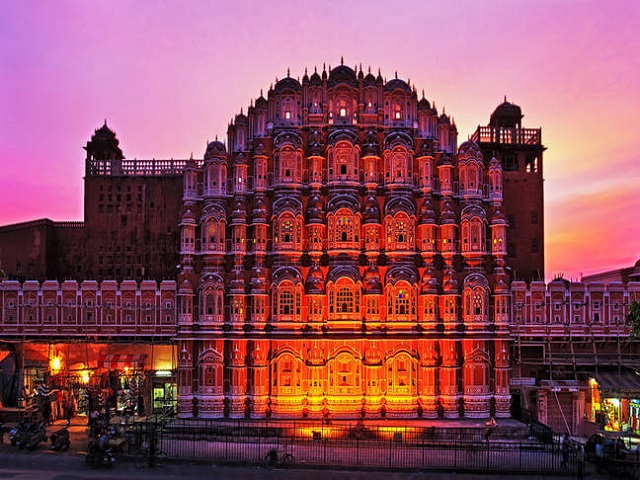
One of the most popular attractions in Jaipur, Hawa Mahal is a stunning 5-storeyed structure that was commissioned by Maharaja Sawai Pratap Singh of Kachhwaha Rajput dynasty in 1799. It is known for its honeycomb of a beehive-like structure with 953 small jharokhas / windows complex latticework through which the royal ladies used to observe day-to-day life on the street below without them being seen by anyone. Designed by Lal Chand Ustad, he drafted it in the form of the crown of Lord Krishna as the commission ruler was the ardent devotee of the Lord.
The entrance of Hawa Mahal is on the backside, leading to a huge courtyard enclosed by two-storeyed structures on 3 sides. An interesting thing about this structure is that it does not have stairs and the floors are connected through slopes. The palace also has a well-stocked archeological museum.
See More:
Top 12 Tourist Attractions in Jaipur
Best Luxury Hotels in Jaipur
Hill fort of Rajasthan
18. Jama Masjid, Delhi
The largest mosque in India, Jama Masjid is counted as one of 10 most famous Jama Masjid mosques in the country. Also known as Masjid-i Jahān-Numā, this was built by Mughal Emperor Shah Jahan between1644 and 1658. The mighty structure of the mosque is in red sandstone and marble and was made by over 5000 artisans. The first 3 storeys of the mosque tower are in red sandstone, the 4th is made of marble, and the 5th one is in sandstone.
The walls of Jama Masjid have detailed carvings as well as verses from the holy Quran. The spacious courtyard of the mosque can accommodate as many as 25000 worshipers at one time. This adorned mosque has three grand gates, two minarets and four towers. Each of the 5 storeys of the mosque has balconies.
19. Chhatrapati Shivaji Terminus, Mumbai

Chhatrapati Shivaji Terminus (CST), a historic railway station in Mumbai and a UNESCO World Heritage Site, was formerly known as Victoria Terminus. A fine example of Victorian-Gothic style of architecture in India, it is also has shades of Mughal architectural traditions. One of the best railway stations in India, its construction started in 1878 and was completed in 10 years. Designed by the British architect F.W. Stevens, the structure has wonderful amalgam of British and Indian designs.
A popular landmark of Mumbai, Chhatrapati Shivaji Terminus spread in an area of 2.85 hectares and is used by as many as 3 million commuters. The turrets and the pointed arches of the station look remarkable. While the main structure is made up of sandstone and limestone, the interiors are adorned with high-quality Italian marble. It has also been the shooting site of a number of Bollywood movies as well as Oscar-winning movie ‘Slumdog Millionaire’.
20. Victoria Memorial, Kolkata

Constructed between 1906 and 1921in the memory of Queen Victorial, The Victoria Memorial is a white marble building that has now been turned into a museum. One of the top tourist attractions in Kolkata, it is also popular for its lush gardens, defined domes and a special, huge royal gallery. Placed alongside the banks of River Hooghly, this memorial has Indo-Saracenic revivalist architecture style, using touches of Mughal, British, Islamic, Venetian and Egyptian traditions of architecture.
While the foundation of the memorial was laid by the Prince of Wales in 1906, its inauguration was done in 1921. The museum houses a wonderful collection of British Raj paintings, Victoria memorabilia along with other showcases such as weapons, coins, maps sculptors, textiles and stamps.
Related Post:
Most Haunted Places in the World
Most Awe Inspiring Landmarks in the World
Most Romantic Islands in the World
Top Luxury Trains in the World
20 Most Spectacular Sunrise and Sunset Points in India


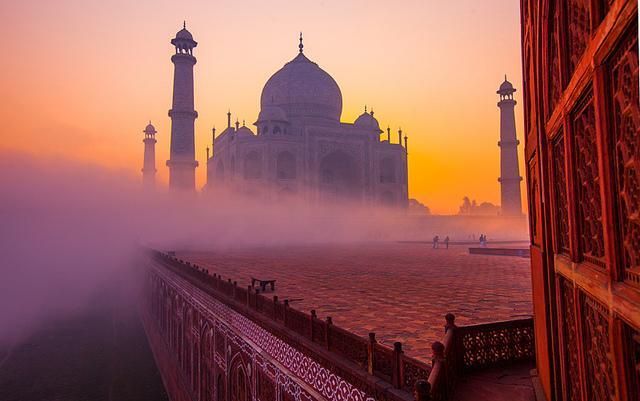
Comment (0)